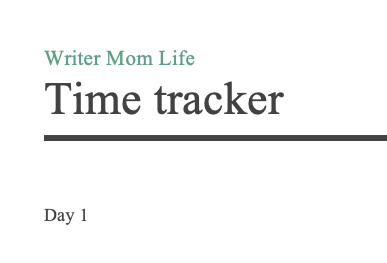A few months ago I shared a template with the Writer Mom Life community that combines two different ways to track your time.

First, track what you do every single day for a week.
Second, track how long individual activities take you.
Yikes, that sounds like a lot of work! And it is. But it’s only for a short period and the results are exciting. This work lays the foundation for that elusive unicorn all writer moms are looking for: more time to write.
For the first task, pick a “normal” week. Not a school vacation week or one when you have overnight visitors. If you can do a little longer than a week, that’s even better, since you’ll spot trends easier.
By tracking every single thing you do for 7 to 10 days, you’ll get a better idea of what you’re really spending your time on. There it is, in black and white, the 2 hours you spent on social media Tuesday night and the 3 hours of binge-watching Hart of Dixie on Friday (totally not a real example, by the way…)
Maybe you’ve already cut down on all that fun stuff and you still can’t find the time to write. Get creative! Can random errands that take up precious evening hours be batched on a weekend morning? Outsourced to a spouse or family member?
If you go to the supermarket 5 times in one week, give meal planning a try. Things like frozen fruits and veggies are just as tasty, cut down on prep time, and don’t require mid-week trips by spoiling faster than expected. Or, maybe someone else be in charge of cooking from time to time.
For any household task ask yourself three questions:
- Does it need to be done at that exact time?
- Does it need to be done by you specifically?
- Will doing it in slightly less time greatly reduce the desired outcome? (see the frozen veggies example above)
These are all suggestions that may have nothing to do with your daily life. Your time tracker will reveal what areas you can focus on to grab extra minutes or even hours for your writing.
Now that you have all this extra time, things may not be going as fast as you expected. Maybe you’ve found 2 hours in your week to work on being an indie author, but your newsletter is always late getting out. Or it seems to fill up with admin tasks instead of actual writing.
You have more time, but you’re feeling more frustrated than ever.
This is where the second step of the time tracker comes in:
Figuring out how long certain tasks take you.
For any completely new task, try not to set any expectations on how long it will take. This sets up your baseline. Or, even if you’ve done something a hundred times, set a timer for the next time you do it. Then, it’s even more helpful to track over the course of a few weeks and months to see if things are consistent, or if you’re getting better.
Both are important to know.
If uploading to KDP took you 2 hours the first time, then you can set aside that much time to do it the second time, rather than getting upset when you unsuccessfully try to fit it into the 30 minutes you have before the kids get off the bus.
If it ends up taking you only 30 minutes out of a 2-hour work block, then think of how awesome you’ll feel having that extra hour and a half!
Maybe you notice your writing speed is 1000 words an hour, and no matter what you do, it doesn’t get faster. That’s totally fine! If, thanks to the first part of the tracker, you expect to have 3 hours a week to write, then you can get 3000 words a week, or over 150,000 words a year. Depending on your genre, that could be as many as three books!
Now you can plan out your writing projects for the year, knowing you’ll be able to meet deadlines, rather than take on every idea that seems interesting and get annoyed with yourself when things get behind because you thought you’d be writing faster by now.
Really, the trick is not in finding more time magically under the couch cushions, but knowing how you spend your time so that you can use it more efficiently.
Get the time tracker here and let us know over in the Facebook group how you’re doing!


Recent Comments